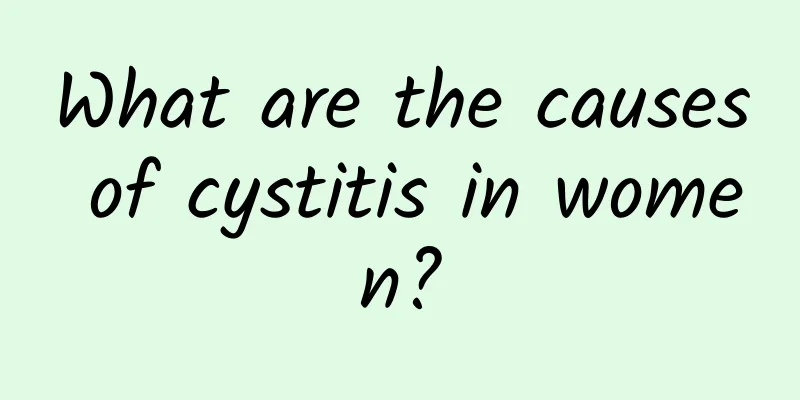What are the causes of cystitis in women?

|
Cystitis is a relatively common urinary system disease, especially women are particularly prone to cystitis. They often experience symptoms such as urgency and frequent urination, which seriously troubles our normal life and also affects our physical health. Since we know very little about cystitis, we don’t always know how to prevent it effectively. Let’s take a look at the causes of cystitis in women. Cystitis is a disease that is more common in women and is one of the most common diseases in the urinary system. Clinically, it can be divided into acute cystitis and chronic cystitis. Nonspecific cystitis is more likely to occur if there are lesions in the female bladder itself, such as bladder stones, foreign bodies, and indwelling catheters, or if there is urinary tract obstruction and urination difficulties. 1. Causes of cystitis in women Cystitis is a lower urinary tract infection, which is more common in women. The pathogen is mostly E. coli. When a woman's urinary system is infected, the bacteria invade through two routes: ascending infection and bloodstream infection. Therefore, cystitis is mostly caused by infection. 1. Urinary tract obstruction: Such as urethral stones, stenosis, tumors, prostate hypertrophy, etc., which make urine excretion difficult, cause bacterial growth and cause infection. 2. Urinary system malformations and abnormal functions: For example, renal hypoplasia, horseshoe kidney, polycystic kidney, ureteral malformation, etc. can cause partial urinary tract obstruction or vesicoureteral reflux, causing infection; abnormal urination function of neurogenic bladder can lead to urinary retention and bacterial infection. 3. Urinary system instrument examination: Catheterization, cystoscopy and urinary tract surgery cause nosocomial infection. 4. Weakened body resistance: Conditions such as diabetes, use of immunosuppressants (such as corticosteroids), leukopenia, and malnutrition can easily lead to urinary tract infections. 5. Improper sexual life: Unclean sexual life and systemic viral infection are often important triggering factors of female cystitis. 2. What are the symptoms of female cystitis? 1. Acute cystitis: It can occur suddenly or slowly. There is burning pain in the urethra during urination, frequent urination, often accompanied by urinary urgency. In severe cases, it is similar to urinary incontinence. The urinary frequency and urgency are often particularly obvious, up to 5 to 6 times per hour. The amount of urine each time is not much, even only a few drops. There may be lower abdominal pain at the end of urination. The urine is turbid, and sometimes there is hematuria, which is often obvious in the late stage. If there is macroscopic hematuria, it is called acute hemorrhagic cystitis. There is mild tenderness in the suprapubic bladder area. Some patients may experience mild back pain. When the inflammatory lesions are limited to the bladder mucosa, there is often no fever or leukocytosis in the blood, and the systemic symptoms are mild. Some patients feel tired. Acute cystitis in women after marriage is called honeymoon cystitis. Acute cystitis has a short course. If treated in time, the symptoms usually disappear in about 1 week. 2. Chronic cystitis: Frequent urination, urgency, and pain during urination are long-term and recurrent, but not as severe as the acute phase. There are small or moderate amounts of pus and red blood cells in the urine. If cystitis is treated promptly, the symptoms will disappear quickly. At this time, patients should not take it lightly and should insist on acute treatment for one week. Stop after the doctor confirms that the cystitis has been cured through examination. Do not let cystitis turn into a chronic disease. In fact, as long as we can pay more attention to and improve bad living habits in life, we can effectively prevent and avoid the occurrence of some diseases. After understanding the causes of female cystitis, we can effectively prevent cystitis. We must pay attention to physical hygiene in daily life and do not have multiple sexual partners. |
<<: 3 ways to hit a man's weak spot in love
>>: How to care for oily skin for men
Recommend
Losing one inch of waist circumference will increase your libido by ten points. Ensuring adequate sleep will help burn fat.
As we age, our waistline also increases. Especial...
Can testicular torsion heal on its own?
Testicular torsion is an acute disease, and most ...
What are the dangers of prostate hyperplasia in men
Men's diseases have similarities with women&#...
Why do men have strong sexual desire? The reason is actually this
Some men have a particularly strong sexual desire...
Burning sensation in the testicles
If male friends do not pay attention to hygiene i...
How to treat organic impotence?
Impotence is a disease suffered by men. It can be...
What is the cause of the itchy bump on the glans?
What is the reason for the red and itchy glans? M...
What foods are good for people with skin allergies?
Many people in life will have allergies. Some peo...
How long does it take to recover from circumcision surgery?
In our lives, many men are troubled by the proble...
What are the foods that men can eat to replenish sperm?
From a medical point of view, sperm is the source...
How to use compound lidocaine cream
The spiny seed lidocaine cream is used for surgic...
Male genitals are not hard enough
If the male genitals are not hard enough during s...
Are impotence and premature ejaculation caused by kidney deficiency?
Kidney deficiency is a common symptom among us. M...
At what age does a man enter menopause? See the experts' introduction
Many people have always thought that menopause is...
Can a beer mask shrink pores? How to do it?
Isn't beer meant to be drunk? Why do some peo...









